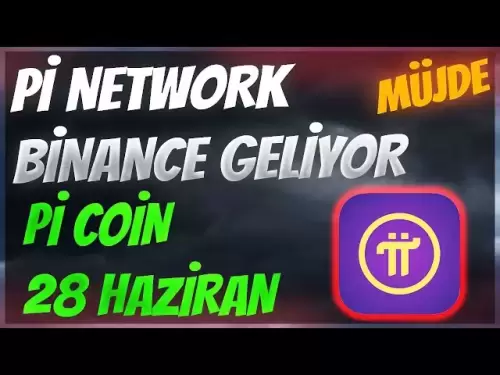 |
|
 |
|
 |
|
 |
|
 |
|
 |
|
 |
|
 |
|
 |
|
 |
|
 |
|
 |
|
 |
|
 |
|
 |
|
Nachrichtenartikel zu Kryptowährungen
How Cryptocurrency Transactions Are Verified
May 01, 2025 at 06:40 am

When you send or receive cryptocurrency, there’s a lot happening behind the scenes to ensure that the transaction is valid and secure. This process of verification is crucial for maintaining trust in the system. In this article, we’ll break down how a transaction is verified on a cryptocurrency network, covering everything from broadcasting the transaction to confirming it on the blockchain.
Key Takeaways
Overview of the Verification Process
So, you wanna know how your crypto transaction actually goes through? It’s more than just hitting ‘send’ on your wallet app. It’s a whole process involving different players and checks to make sure everything’s legit. Think of it like a digital handshake that everyone on the network has to agree on.
Transaction Broadcast
Okay, first things first: you hit ‘send’. That kicks off what’s called transaction broadcasting. Basically, your transaction gets shouted out to a bunch of computers (nodes) all over the network. These nodes are like the town criers of the crypto world, spreading the word. They check if you actually have the funds you’re trying to send and if your digital signature is valid. It’s like showing your ID at the door.
Mining or Validation
Next up, we’ve got mining (in Proof-of-Work systems) or validation (in Proof-of-Stake systems). This is where the real work happens. Miners or validators are like the accountants of the blockchain. They bundle up a bunch of transactions, including yours, and try to solve a complex puzzle. In Proof-of-Work, this puzzle requires a ton of computing power. In Proof-of-Stake, validators stake their own crypto to get the chance to validate transactions. Either way, the goal is to create a new block of transactions that can be added to the blockchain.
Consensus Mechanisms
So, how do we know that the miners or validators aren’t cheating? That’s where consensus mechanisms come in. These are the rules of the game that everyone has to follow. Proof-of-Work and Proof-of-Stake are two popular examples, but there are others. The important thing is that these mechanisms ensure that everyone agrees on which transactions are valid and which block should be added to the chain. It’s like having a referee in a sports game.
Role of Miners and Validators
Miners and validators are the unsung heroes of the crypto world. They’re the ones who keep the network running smoothly and securely. They use their resources (computing power or staked crypto) to validate transactions, create new blocks, and maintain the integrity of the blockchain. In return for their efforts, they get rewarded with newly minted crypto or transaction fees. It’s like getting paid to keep the books balanced.
Transaction Confirmation
Once a block has been added to the blockchain, your transaction is considered confirmed. But it’s not just one confirmation that matters. The more confirmations a transaction has, the more secure it is. Each new block added to the chain makes it harder and harder to tamper with previous transactions. It’s like building a wall, brick by brick.
Block Creation
Blocks are the fundamental building blocks of the blockchain. Each block contains a bunch of transactions, a timestamp, and a link to the previous block. This linking is what makes the blockchain so secure. If you try to change a transaction in an earlier block, you’d have to change all the subsequent blocks as well, which is practically impossible. It’s like trying to rewrite history.
Network Integrity
All of these steps work together to ensure the integrity of the network. The decentralized nature of the blockchain, combined with the consensus mechanisms and the cryptographic security, makes it very difficult for anyone to cheat the system. This is what gives cryptocurrencies their value and makes them a trusted form of digital money.
The whole process is designed to prevent things like double-spending, where someone tries to spend the same crypto twice. It’s also designed to be resistant to censorship, meaning that no single entity can block or reverse a transaction.
So, next time you send a crypto transaction, remember that there’s a lot going on behind the scenes to make sure it goes through safely and securely. It’s a complex process, but it’s what makes cryptocurrencies so powerful.
Understanding Transaction Broadcasting
Definition of Transaction Broadcasting
Transaction broadcasting is the initial stage where a cryptocurrency transaction is announced to the network. Think of it like sending out a memo to everyone involved. When you initiate a transaction on your preferred cryptocurrency exchange or wallet, your action doesn’t immediately update the blockchain. Instead, your transaction request is broadcast to nodes in the network. These nodes maintain a copy of the blockchain and perform checks to ensure the transaction’s validity.
Importance of Broadcasting
This broadcasting process is crucial because it notifies the network about the pending transaction. Miners or validators, who are responsible for adding new blocks to the blockchain, pick up transactions from the pool and try to include them in the next block. Transaction
Haftungsausschluss:info@kdj.com
Die bereitgestellten Informationen stellen keine Handelsberatung dar. kdj.com übernimmt keine Verantwortung für Investitionen, die auf der Grundlage der in diesem Artikel bereitgestellten Informationen getätigt werden. Kryptowährungen sind sehr volatil und es wird dringend empfohlen, nach gründlicher Recherche mit Vorsicht zu investieren!
Wenn Sie glauben, dass der auf dieser Website verwendete Inhalt Ihr Urheberrecht verletzt, kontaktieren Sie uns bitte umgehend (info@kdj.com) und wir werden ihn umgehend löschen.
-

-

-

-

- Remittix Could Be a Turning Point for Investors as Its RTX Crypto Presale Continues to Headline in Q2
- Jun 15, 2025 at 12:25 pm
- The latest XRP news continues to shape market sentiment as Ripple navigates trading developments. Meanwhile, the Dogecoin price prediction remains uncertain given the price fluctuations across the global market.
-

-

-

-

-

- Michael Saylor Returns to the Limelight by Arguing Bitcoin Is a 'Newtonian Network'
- Jun 15, 2025 at 12:10 pm
- Michael Saylor — executive chairman of MicroStrategy and one of the most outspoken Bitcoin advocates — has returned to the limelight with a post arguing that Bitcoin is a “Newtonian Network.”





























































